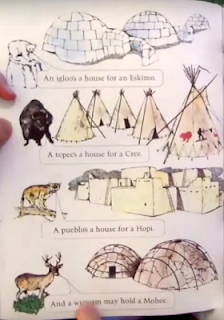On April 27, 2016, Jessica Donaghy posted The Top 100 Children's Books on Goodreads. To determine which chapter and middle grade books should be "on every kid's shelves" they "looked for the best reviewed books, all with average ratings above a 4.0 (a high bar that cuts out giants like Ramona and Huck Finn)."
 |
| Stereotypical representations: thumbs down |
Of course, such lists get circulated on social media.
The Children's Book Council tweeted it, and then John Schu tweeted it, which is how I saw it.
Looking it over, I gotta give it a thumbs down for the Native representations on it. Come on, people! How about, when you look at these kinds of lists, you ask yourself about Native representations on it. We all have to speak up for change to happen!
I'm thrilled to see several authors of color on the list. I see Jackie Woodson's
Brown Girl Dreaming. And Kwame Alexander's
Crossover, too. And Pam Munoz Ryan's
Echo. And several titles by Sharon Draper. And Grace Lin's
Where the Mountain Meets the Moon.
But what about Native writers? None. Louise Erdrich's
Birchbark House ought to be on here, don't you think? Nothing on it by the most prolific Native writer either! I mean Joseph Bruchac.
What about Native characters or stories that aren't stereotypical? Again, none. Here's the list of titles. The ones in bold are ones that have stereotypical Native characters. Those two? The grunting and animal-like Indians in
Little House on the Prairie and the stereotypical Tiger Lily and playing-Indians of
Peter Pan.
What did and did not got onto this list reflects two things: a visibility problem, and, a refusal to let go of books with stereotypical content. What will you do about that? Who else is missing, I wonder?
Aesop's Fables
Alice's Adventures in Wonderland, by Lewis Carroll
Amulet, by Kazu Kibuishi
Anne of Green Gables, by L.M. Montgomery
The Arabian Nights
Avatar: The Last Airbender, by Gene Luen Yang
Awkward, by Svetlana Chmakova
A Bear Called Paddington, by Michael Bond
The Black Stallion, by Walter Farley
Bone, by Jeff Smith
Book of Three, by Lloyd Alexander
The Borrowers, by Mary Norton
The Boxcar Children (#1), by Gertrude Chandler Warren
Brown Girl Dreaming, by Jacqueline Woodson
Calvin and Hobbes, by Bill Watterson
Chains, by Laurie Halse Anderson
Charlie and the Chocolate Factory, by Road Dahl
Charlotte's Web, by E.B. White
Coraline, by Neil Gaiman
Crossover, by Kwame Alexander
Dealing with Dragons, by Patricia C. Wrede
The Devil's Arithmetic, by Jane Yolen
The Diary of a Young Girl, by Anne Frank
Drama, by Raina Telgemeier
Echo, by Pam Munoz Ryan
El Deafo, by Cece Bell
Fablehaven, by Brandon Mull
The False Prince, by Jennifer A. Nielsen
From the Mixed Up Files of Mrs. Basil E. Frankweiler, by E. L. Konigsburg
The Giver, by Lois Lowry
Gracefully Grayson, by Ami Polonsky
The Graveyard Book, by Neil Gaiman
Grimm's Fairy Tales
A Handful of Stars, by Cynthia Lord
Hans Christian Andersen Fairy Tales
Haroun and the Sea of Stories, by Salman Rushdie
Harry Potter and the Sorcerer's Stone, by J.K. Rowling
The Hobbit, by J. R. Tolkien
Howl's Moving Castle, by Diana Wynne Jones
The Incredible Journey, by Sheila Burnford
Inside Out and Back Again, by Thanhha Lai
Into the Wild (Warriors), by Erin Hunter
The Invention of Hugo Cabret, by Brian Selznick
Just So Stories, by Rudyard Kipling
The Lightning Thief, by Rick Riordan
The Lion, the Witch, and the Wardrobe, by C. S. Lewis
The Lions of Little Rock, by Kristin Levine
Little House on the Prairie, by Laura Ingalls Wilder
The Little Prince, by Antoine de Saint-Exupery
A Little Princess, by Frances Hodgson Burnett
Little Women, by Louisa May Alcott
A Long Walk to Water, by Linda Sue Park
Mary Poppins, by P. L. Travers
Matilda, by Roald Dahl
The Mighty Miss Malone, by Christopher Paul Curtis
The Miraculous Journey of Edward Tulane, by Kate DiCamillo
Mockingbird, by Kathryn Erskine
Mrs. Frisby and the Rats of NIMH, by Robert C. O'Brien
Mrs. Piggle Wiggle, by Betty MacDonald
My Side of the Mountain, by Jean Craighead George
My Sweet Orange Tree, by Jose Mauro de Vasconcelos
The Mysterious Benedict Society, by Trenton Lee Stewart
The Name of this Book is Secret, by Pseudonymous Bosch
The Neverending Story, by Michael Ende
Number the Stars, by Lois Lowry
Old Yeller, by Fred Gipson
The One and Only Ivan, by Katherine Applegate
Out of My Mind, by Sharon M. Draper
Peter and the Starcatchers, by Dave Barry
Peter Pan, by J. M. Barre
The Phantom Tollbooth, by Norton Juster
Pippi Longstocking, by Astrid Lindgren
Princess Academy, by Shannon Hale
The Red Pyramid, by Rick Riordan
The Red Umbrella, by Christina Diaz Gonzales
Redwall, by Brian Jacques
Ranger's Apprentice, by John Flanagan
Sadako and the Thousand Paper Cranes, by Eleanor Coerr
Scary Stories to Tell in the Dark, by Alvin Schwartz
The Secret Garden, by Frances Hodgson Burnett
See You at Harry's, by Jo Knowles
Sideways Stories from Wayside School, by Louis Sachar
The Skin I'm In, by Sharon G. Flake
Smile, by Raina Telgemeier
So Be It, by Sarah Weeks
Stella by Starlight, by Sharon M. Draper
The Story of a Seagull and the Cat Who Taught Her to Fly, by Luis Sepulveda
Tales of a Fourth Grade Nothing, by Judy Blume
The Two Princesses of Bamarre, by Gail Carson Levine
Watership Down, by Richard Adams
The Westing Game, by Ellen Raskin
When You Reach Me, by Rebecca Stead
Where the Mountain Meets the Moon, by Grace Lin
Where the Red Fern Grows, by Wilson Rawls
Where the Sidewalk Ends, by Shel Silverstein
Winnie the Pooh, by A. A. Milne
The Land of Stories and the Wishing Spell, by Chris Colfer
Wolf Brother, by Michelle Paver
Wonder, by R. J. Palacio
A Wrinkle in Time, by Madeleine L'Engle




































